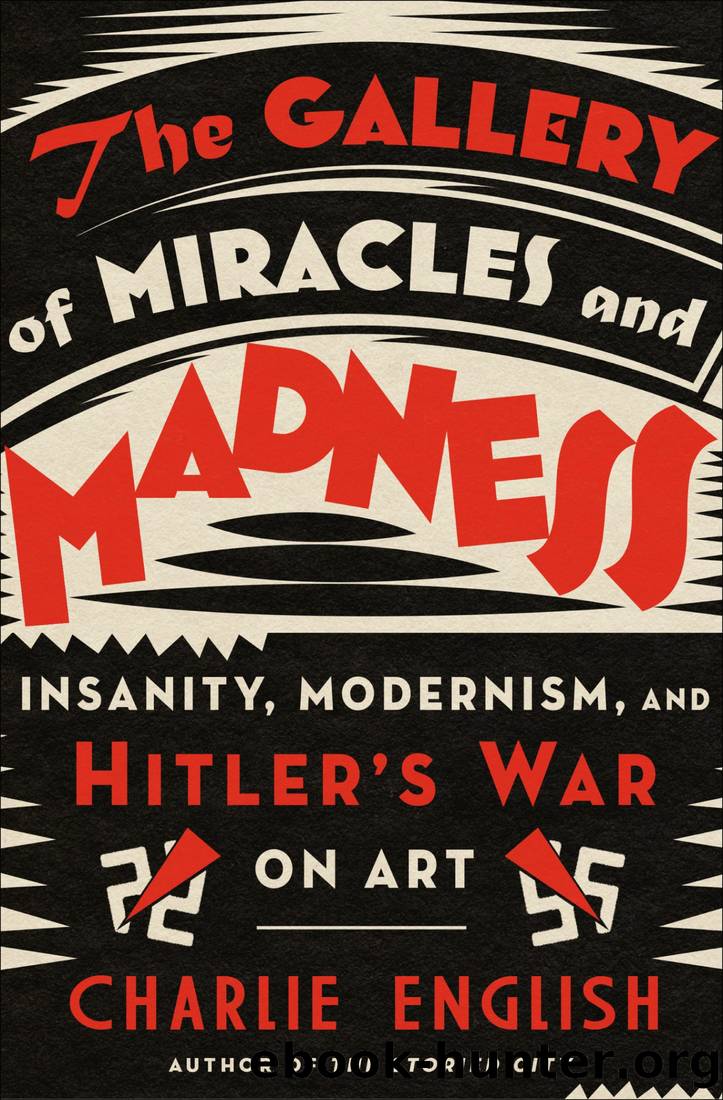The Gallery of Miracles and Madness by Charlie English

Author:Charlie English [English, Charlie]
Language: eng
Format: epub
Published: 2021-08-10T00:00:00+00:00
* * *
â
From the first days, it was clear that Entartete Kunst was a hit, far more popular than the GroÃe deutsche Kunstausstellung. More than a million visitors would shoulder their way through the overcrowded rooms of the Archaeological Institute by the end of August. As the Nazi press trumpeted the âartistic inferno,â Hitler and Goebbels traveled to Bayreuth for the Wagner festival, a long-standing fixture of the regimeâs summer season. Hitler stayed as the guest of the family in the late composerâs villa, the Haus Wahnfried. (Wagner had explained his villaâs name, which means âmad peace,â with an inscription over the door that read: âHere where my madness has found peace, let this place be named Wahnfried.â) Basking in his victory, in the bosom of the Wagner clan, âUncle Adolfâ lavished approval and attention on Goebbels. âTo the Führer at Haus Wahnfried, where I am also staying,â the minister noted in his diary for Saturday, July 24. âFührer very niceâ¦The exhibition Entartete Kunst is a huge success and a big blow.â Here, between interminable operas, the pair discussed how to further exploit their confrontation with modern art.
Their first decision was that Entartete Kunst should come to Berlin in the autumn. Goebbels favored putting it on at the Kronprinzenpalais, where it would have a humiliating resonance. The Nationalgalerie should also be ordered to take a quarter of the works shown in the GroÃe deutsche Kunstausstellung, which was to become an annual event. Eberhard Hanfstaengl should be sacked; Paul Ortwin Rave would be appointed director in his place.
Next, the two men decided that the confiscation of âdegenerateâ material must now be prosecuted systematically. Hitler gave Goebbels authority to seize all such works in German collections, and the propaganda minister telephoned Ziegler, telling him to âclean the museums.â To perform this vast, secret campaignâwhich Rave later described as ârape,â âlooting,â and âmutilationâârequired a dramatic scaling-up of the confiscation commissions. The extreme nature of the purge, which he estimated would take three months, appealed to Goebbels. âThis is how it must be done,â he wrote. âAwaken the peopleâs interest by means of great actions.â
In mid-August, Rave was forced to look on in horror as a gang of anti-modern philistines, including Walter Hansen, rifled the Nationalgalerieâs priceless collection in a raid of âincomprehensible unscrupulousness.â Apart from the personal insults and moral wrongs inflicted on the artists and institutions, he estimated that the damage to the galleryâs inventory amounted to more than a million gold marks. Incalculable harm was also done to the countryâs reputation. Goebbels had stipulated that âworks of German degenerate art since 1910â were to be removed, but the commissioners also took works by foreign artists such as Cézanne, Van Gogh, and Munch, to whom, in an earlier life, Goebbels had once sent a congratulatory seventieth-birthday telegram. Hansen reviled Van Gogh in particular for his supposed mental illness. He even wanted to confiscate the works of Grünewald, whom he called psychotic, and Rembrandt, who had painted Jewish ghettos, but in these cases he was overruled.
Download
This site does not store any files on its server. We only index and link to content provided by other sites. Please contact the content providers to delete copyright contents if any and email us, we'll remove relevant links or contents immediately.
Inner Engineering: A Yogi's Guide to Joy by Sadhguru(6705)
The Power of Now: A Guide to Spiritual Enlightenment by Eckhart Tolle(5584)
Fear by Osho(4644)
Ikigai by Héctor García & Francesc Miralles(4102)
The Art of Happiness by The Dalai Lama(4051)
The Ultimate Bodybuilding Cookbook by Kendall Lou Schmidt(3872)
Yoga Therapy by Mark Stephens(3686)
The Little Book of Hygge by Meik Wiking(3589)
The Healing Self by Deepak Chopra(3453)
Why Buddhism is True by Robert Wright(3388)
Being Aware of Being Aware by Rupert Spira(3215)
The Hatha Yoga Pradipika (Translated) by Svatmarama(3204)
Shift into Freedom by Loch Kelly(3121)
Wild Words from Wild Women by Stephens Autumn(3076)
Work Clean by Dan Charnas(3035)
Happiness by Matthieu Ricard(2975)
More Language of Letting Go: 366 New Daily Meditations by Melody Beattie(2955)
Yoga Body & Mind Handbook by Jasmine Tarkeshi(2821)
Why I Am Not a Feminist by Jessa Crispin(2682)
